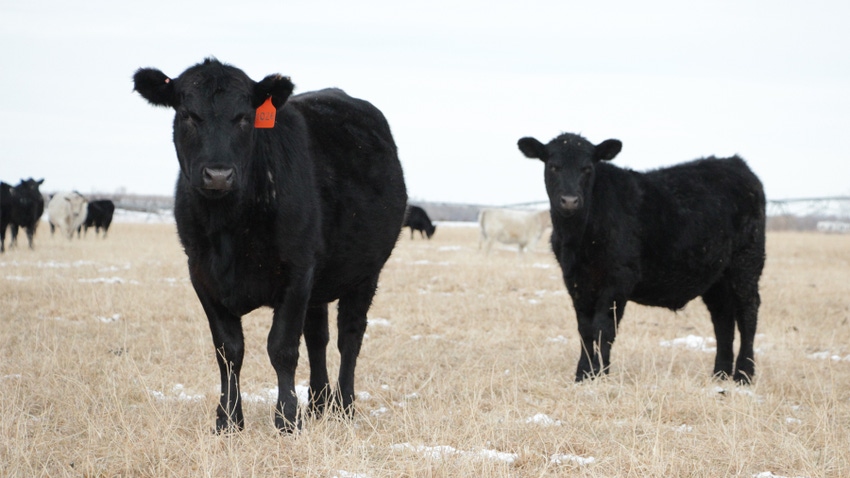
For cattle producers, visual indicators of animal health are often the first hint that something might be wrong. Body condition score is just one visual that is a quick way to monitor nutritional status of the animal.
The beef BCS scale ranges from 1 to 9 — with 1 being extremely thin and 9 being extremely obese. A normal range is between 3 and 7 — with 4 to 6 being in the ideal range. Evaluating these six points can determine the BCS on beef animals:
spine
tail head
pins
hooks
ribs
brisket
Taking an ideal BCS of 5, producers can see a slight outline of the spine with a couple ribs showing, and no additional fat in her brisket. These sights will vary with the specific animal’s score. These management tips from South Dakota State University Extension experts can help producers keep their animals at a prime BCS throughout the year:
Spring. With the spring often comes late gestation and calving for the cow herd. Late gestation is the last opportunity to increase BCS before calving begins, and mature cows should rate a 5, with heifers rated a 6. For cows in late gestation, most nutrients will be allocated to fetal growth.
Cows should be gaining a minimum of 1.2 pounds per day for appropriate fetal development, and thin cows may need to gain 1.5 to 2 pounds per day to reach a BCS of 5. As this can be challenging during late gestation, SDSU suggests a ration change for the herd.
One example ration is 25 pounds of medium-quality hay, made up of 7% crude protein and 56% TDN, combined with 4 pounds of dried distillers grain plus solubles. This example ration will allow a 1,350-pound animal to gain 58 pounds over a 90-day period.
After calving, an animal’s nutrient demand reaches its peak during lactation. It is good practice to record each cow’s BCS at calving to reference in the future. Depending on the economic opportunity, it is beneficial to increase cow nutrients during lactation. Heifers should be offered a lactation ration to help offset nutritional demand in younger animals.
For cows who calve in green pastures, they should continue to gain condition after calving. For cows fed harvested feeds, this becomes more difficult and expensive to meet nutrient needs. Cows who were thin at calving are even more challenging. Working with a nutritionist or Extension agent to develop a ration for these animals provides the greatest opportunity to meet production goals.
Summer. BCS for all females should be evaluated again in early summer, checking for gains or losses after calving. Drought conditions and thin grass are not favorable to increase BCS of cows prior to weaning. Early weaning of calves removes the nutrient demand on cows, allowing her to gain condition on a lower quality and quantity of ration.
Calves that are weaned early also lead to feed savings, as they will gain in a feedlot setting in preparation for the next calving season. This leads to lower feed costs for the producer and allows forage to be stretched during drought.
Thin cows may benefit from early weaning, as they have reduced nutrient requirements from lactation and can prepare for the upcoming winter and breeding season. Adequate water, salt, mineral and vitamin mix for these animals also benefits these cows.
Depending on the operation’s management, cows may be bred during the early summer as well. Monitoring BCS during breeding time can help producers spot cows who maintained, gained or lost BCS through calving and lactation. Cattle who were able to gain during this phase are often a better opportunity, according to research, as the cow will first allot nutrient to her own body condition and then to lactation. If still available after these requirements, the nutrients will then be allocated to reproductive processes. For cows who are not receiving enough nutrients, the first thing compromised is reproduction.
Fall. As winter nears, another round of BCS should be done on all females. Calves who were not weaned in the summer should be off to the pasture or feedlot, allowing the cows to gain condition without additional nutrient demand. The most economical time to improve BCS is this mid-gestation window following weaning.
Condition scoring cows in the fall is critical, as it can be more difficult to get condition back on cows prior to calving with potentially dwindling feed resources on pasture. Producers who have cool-season pasture and crop residues, the early-fall condition scores might not be as critical as those grazing warm-season grasses.
Recording each cow’s BCS during pregnancy checking is an easy way to ensure the animal is having nutrient needs met. Scores during this time will also assist in planning an economical winter ration and supplementation program to get females back to an ideal BCS.
Winter. The winter months are often the last opportunity to get condition back on cows before calving. This time also serves as a chance to separate first and second calf heifers, or thin older cows from the herd to ensure enough feed is provided. Alfalfa hay or protein supplement can assist in adding condition back to these animals.
Feeds in the winter-feeding program can be tested for quality, and heifers should be started on a balanced ration designed for the last third of gestation. Adequate salt, mineral and vitamin mix should be offered free choice during this time.
Consistent scoring, proper record-keeping and continual checking of BCS throughout the production year can ensure your cow herd can remain ideal all year long.
South Dakota State University Extension and University of Nebraska-Lincoln Extension contributed to this article.
About the Author(s)
You May Also Like






